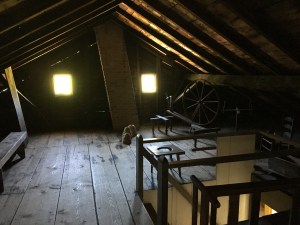
Often in my reading, I’ll come across the fact that the Ontario Mennonites helped the Manitoba Mennonites when they first arrived in Canada. That’s because the Ontario folks had already been here for well over a century. In fact, many Manitoba-bound Mennos spent an entire winter with the Ontario Mennonites, and borrowed money from them too. I have no sources to cite here; these are just things I remember reading on various occasions.
All of this has seemed pretty abstract to me, because I myself had barely learned about Ontario Mennonites, nor had I seen any evidence of these fabled helpful, well-established folk. Until this past summer, that is. It was a blisteringly hot day in late June when Andrew and I pulled up at the Schneider Haus National Historic Site in Kitchener.
Join us for a quick look around!

A plaque! It says: “Built around 1816, this house is a reminder of the migration of Pennsylvania-German Mennonites to Waterloo County in the early 19th century. The movement was led by Joseph Schneider, the builder of the house, and his brother-in-law Bishop Benjamin Eby, with the goal of creating a new colony in Upper Canada. The city of Kitchener grew up around their properties, becoming the centre of German culture in Ontario. One of the best preserved pioneer dwellings in the region, the house faithfully reflects the distinctive vernacular plan developed by Mennonites in the pre-revolutionary American colonies.”

We joyfully escaped the sun, finding shelter in the museum. We paid our entrance fee and began our self-guided tour.

Actually, it wasn’t entirely self-guided. You see, in the summer months you’ll find people wearing period costumes, ready to tell visitors about the Mennonites.

It was a little disconcerting to be asked, “Have you ever heard of Mennonites?”
Andrew and I looked at each other. We then looked at the volunteer, kind of laughed, and told her, “Um, we are Mennonites.”

Of course, then I got all existential, wondering, am I a Mennonite?
Oh look, something Catharina Shantz embroidered in 1836!






The above sign says: “This house, constructed in 1820 by Joseph Schneider (1772-1843), is the oldest surviving dwelling in KItchener. Built of frame and originally covered with roughcast, it has been little changed externally since 1850. Schneider, a native of Lancaster County, Pennsylvania, purchased this lot in April 1807 in the German Company tract in Waterloo Township. He arrived here in June of that year, and after clearing his farm and cutting a road along the line of Queen Street, built a sawmill in 1816. Shortly thereafter, a small settlement began to form along ‘Schneider’s Road’ partly on his land, which became the village of ‘Berlin’ and the nucleus of the city of Kitchener.”

I would’ve loved to spend a lot more time here, so hopefully we will return someday. Thanks for joining us for this quick little jaunt!
(A note about the “Berlin” reference above. Yeah, that was Kitchener’s original name, but I think it was during one of the World Wars that they figured they’d best change it up.)

